How to Market Your Videos in 2025
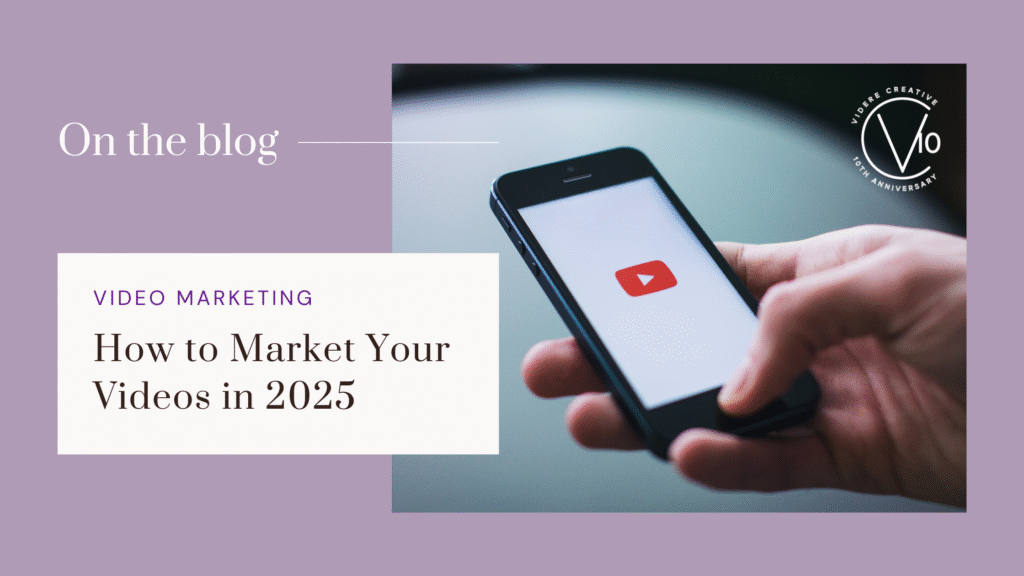
Platforms That Deliver Results Creating a great video is just the first step. If you’re not putting it in the right places—or repurposing it across channels—you’re leaving views, clicks, and conversions on the table. The value of your video lies in how well you distribute it, how often you reuse it, and whether it actually reaches the people it was made for. Without a smart marketing strategy, even the best video can fall flat. And not all platforms are created equal. According to Wyzowl’s 2025 video marketing statistics, some channels consistently drive results—while others lag far behind. For small businesses, that means success isn’t just about making great videos—it’s about placing them where they’ll actually perform. The good news? You don’t need to be everywhere. You just need to be strategic. Here’s where to focus your video marketing efforts in 2025, and how to make the most of each platform. Start with LinkedIn (Yes, Really) For the first time, LinkedIn outranked every other platform as the most widely used video marketing channel. And it’s not just about reach—59% of marketers also say it delivers results. If your business targets professionals, decision-makers, or operates in the B2B space, this is your sign to prioritize LinkedIn. Share native video posts, repurpose webinar clips, or add video to your company page updates. Engagement here tends to be more thoughtful, and your content is more likely to be seen by the people who matter. How to Use It: Create polished, value-driven videos like tutorials, case studies, or industry insights. Post natively on LinkedIn to boost engagement (or a third party that posts natively, like we use!). Experiment with LinkedIn ads to amplify your video’s reach to specific industries or job roles. Instagram Is Still a Powerhouse Instagram currently ranks as the most effective platform for video marketing, with 61% of marketers saying it drives results. Short-form Reels are a natural fit for brand storytelling, quick tips, or product showcases. And with the right sound and captions, discoverability is built in. The key is consistency and clarity—make sure each video has a strong hook in the first 3 seconds. How to Use It: Prioritize Reels for short, punchy, high-energy videos with clear value or entertainment. Use on-screen captions and trending audio to improve watch-through rates. Include calls to action in your captions (e.g., “Comment if you’ve tried this,” or “Save this tip for later”). Don’t Sleep On Facebook (Yet) Facebook may feel a bit outdated, but it still ranks highly for both usage and effectiveness. In fact, 66% of marketers use it, and over half report strong results. It’s particularly useful if your target audience skews older or local. Try combining your video content with paid ads or boosted posts to expand your reach beyond organic followers. How to Use It: Upload videos directly to Facebook for better algorithm visibility (or a third party that uses direct posting, but very few do). Use video in Facebook ads for events, promos, or offers—especially for local targeting. Share behind-the-scenes videos or customer stories to build connection and trust with your audience. Host a Webinar—and Repurpose It Webinars are often treated as one-time events, but they’re goldmines for ongoing content. With 51% of marketers using webinars and nearly half saying they see strong ROI, this format is far from dead. Once it’s over, chop up your webinar into short clips for social, turn it into a YouTube playlist, or transcribe it into a blog. One good webinar can fuel your content calendar for weeks or even months! How to Use It: Record your webinars and trim key takeaways into short-form clips for LinkedIn or Instagram. Use snippets as lead magnets or in email campaigns. Host webinars around product launches, how-tos, or expert panels, and promote with countdowns and reminders across platforms. What About YouTube? Even though YouTube was accidentally omitted from Wyzowl’s 2025 survey, past data makes one thing clear: it remains a dominant force in video marketing. With 90% of marketers using it and 78% saying it drives results (as of 2024), YouTube continues to be a cornerstone for long-form, searchable video content. Its value lies not just in audience size, but in longevity. YouTube videos can continue gaining traction months or even years after they’re published—especially if they’re optimized for keywords and aligned with your audience’s search intent. It’s also ideal for housing playlists, tutorials, behind-the-scenes content, and repurposed webinar recordings. Pro Tip: Don’t forget to fill out the description box with keywords, links, and CTAs. YouTube is owned by Google, and a well-optimized video can boost your visibility across both platforms. Skip These for Now While there’s always room for creativity, some platforms just aren’t delivering the same ROI. According to the latest data, platforms like X (formerly Twitter), Snapchat, and formats like Virtual Reality (VR) and 360 video are among the least used—and least effective—for marketers. Unless your brand has a highly niche audience or a specific use case (like immersive tech demos), your time and budget are probably better spent elsewhere. Focus instead on platforms where your efforts are more likely to drive engagement, leads, and long-term growth. Make Every Video Count Video remains one of the most powerful tools in your marketing toolkit, but only if you use it wisely. You don’t need to be everywhere. You just need to be where your audience is—and where your content can actually convert. In 2025, that means focusing your efforts on LinkedIn, Instagram, YouTube, and webinars. These platforms offer the best mix of reach, engagement, and long-term value, especially when paired with a clear distribution strategy. Need help building one? Let’s talk about how to make your videos work harder—for less effort.
A Simplified 3-Step Strategy to Start Video
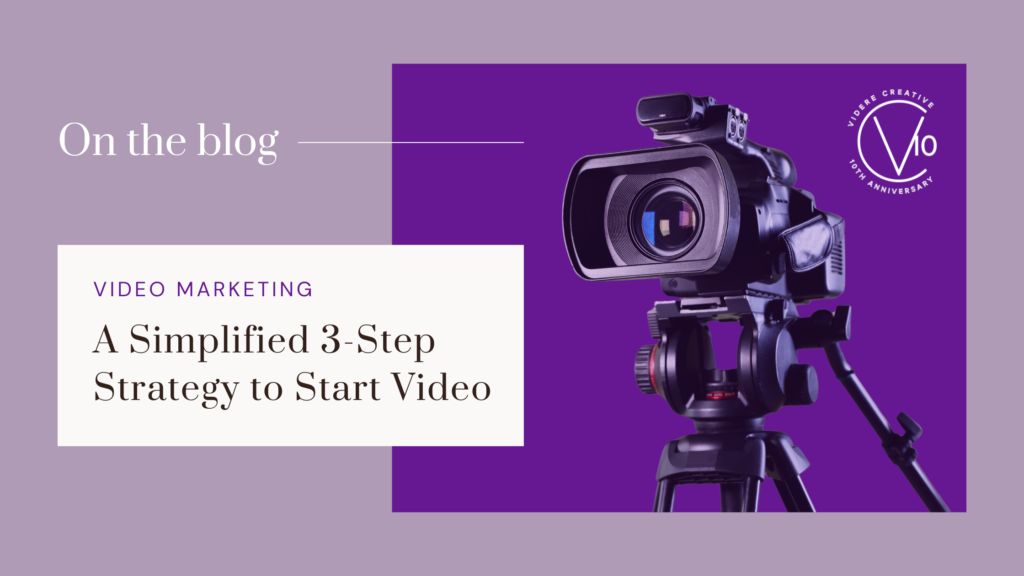
Feeling overwhelmed by video tech and nuances? You’re not alone. It’s easy to get stuck in analysis paralysis—watching countless tutorials, debating equipment choices, and psyching yourself out before even pressing the record button. The way you present yourself on camera directly influences how your audience perceives your credibility and professionalism. Your professionalism should reflect that of your target client. Out-of-focus and hard-to-hear will not attract your target audience. But here’s the truth: video doesn’t have to be complicated. With the right approach, you can cut through the confusion and start creating videos that make an impact—without needing to be a tech expert or spend a fortune on gear. Let’s break it down into three simple, strategic steps that help you stop overthinking and start creating. Step 1: Start with Strategy Every video you create should serve a clear purpose. Whether it’s building trust with your audience, generating leads, or demonstrating your expertise – strategy is what separates “just another video” from a powerful marketing tool. Know Your Goal – Are you educating, entertaining, or selling? Defining your video’s purpose ensures it aligns with your overall marketing strategy. Speak to Your Audience – Effective videos address a specific pain point or interest. Who are you speaking to, and what do they need to hear? Call to Action (CTA) – Every video should guide viewers toward a next step, whether it’s visiting your website, subscribing, or booking a call. Step 2: Polished and Professional You don’t need a fancy budget, but quality matters. High-quality visuals and audio elevate your brand perception and make people take you more seriously. The way you present yourself on camera directly influences how your audience perceives your credibility and professionalism. Your professionalism should reflect that of your target client. Out-of-focus and hard-to-hear will not attract your target audience. To that end, focus on these three elements: Setup – A good camera (i.e. not the standard one in your laptop), decent lighting, and clear audio instantly set you apart from the crowd. Even a well-positioned smartphone can work wonders with the right setup. Framing – Keep those decent lights out of the shot and make sure your background is tidy. Proper framing shows you are thoughtful and care about how your brand is presented. Audio – Bad audio can ruin a great video. Invest in a lapel microphone or tabletop mic to ensure clear, professional sound. There are so many affordable, quality options out now, many with USB and mobile phone input options. Step 3: Keep it Consistent Consistent, quality video content impacts your audience by building the coveted “know, like, and trust” factor. When people see you show up regularly, they begin to recognize your expertise, feel more connected to your brand, and most importantly—keep you top of mind for when they need you. Here are a few ways to stay consistent while keeping your content effective and engaging: Stick to a Schedule – Regular content keeps your brand fresh in your audience’s mind. Even one well-produced video per week can make an impact. Short & Sweet Works Best – Studies show that 73% of people prefer videos between 30 seconds and 2 minutes. Start with shorter videos and expand as needed. The Psychology of Quality – People subconsciously associate well-produced videos with professionalism and credibility. The extra effort pays off. Fight off the Fear of Starting Have you ever thought: What if I or my videos don’t look good? What if my message isn’t clear enough? Am I really an expert? Will anyone even care? Perfection is the enemy of progress, and it’s not the goal here, anyway: connection is! The sooner you start, the sooner you improve. Your audience values authenticity over flawless production, and with the right tools and guidance, you’ll create videos that resonate. Remember, every expert started as a beginner—what matters most is taking that first step and refining as you go. The Power of Video Marketing Video is one of the most effective tools for business growth, and the numbers prove it. A staggering 99% of video marketers report that video has helped increase user understanding of their product or service—an all-time high. This means that well-crafted videos don’t just capture attention; they educate, clarify, and simplify complex information in a way that resonates with viewers. Whether you’re demonstrating a product, explaining a service, or sharing insights – video allows your audience to absorb and retain information more effectively than text alone. Beyond education, video is a powerhouse for brand awareness. 96% of video marketers say video has helped them boost brand recognition. Start Creating Videos with Confidence Video marketing doesn’t have to be overwhelming. With a solid strategy, professional presence, and consistent execution, you can create content that engages, builds trust, and grows your business. The key is to start—because every video you make brings you one step closer to mastering the medium and connecting with your audience in a meaningful way. But you don’t have to do it alone. At Videre Creative, we help businesses cut through the complexity and harness the power of video to drive real results. Whether you need guidance on strategy, a production plan, or editing execution, our team is here to support you every step of the way. Ready to take your video marketing to the next level? Let’s collaborate and bring your brand to life! *This simple, strategic approach was initially developed by Dan Bennett, Founder of “Video For Entrepreneurs,” to help entrepreneurs look and sound great on camera.
Digital Marketing Best Practice Updates: Elevate Your Service-Based Business
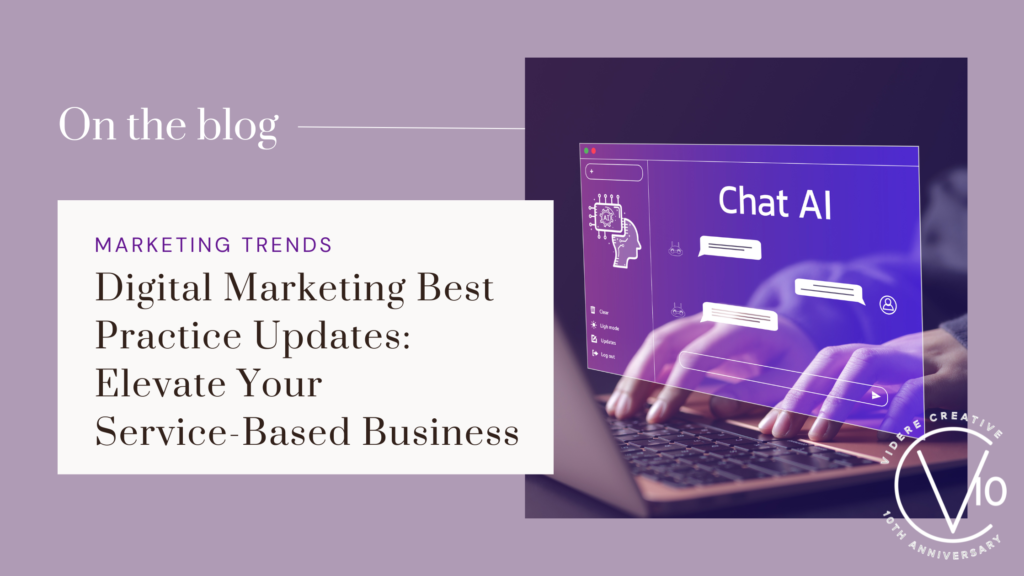
It’s 2025 and digital marketing is everywhere. Technological advancements, shifting user behaviors, and emerging trends are all advancing the digital marketing landscape rapidly. If you are a service-based business aiming to engage your audience and maintain a competitive edge, you must adapt your digital marketing strategies to embrace change. We’re almost to Q2, and fatigue from being overwhelmed by change may be setting in. The last thing business owners want to do is spend countless hours researching the latest digital marketing trends and algorithm shifts – on top of actually working with clients. So we’ve done it for you! Here are the current most impactful and innovative digital marketing best practices, specifically tailored for service-based businesses. 1. Embrace AI-Driven Personalization for Enhanced Client Experiences Why It Matters:Artificial Intelligence (AI) has transformed customer interactions beyond basic chatbots. In 2025, AI will be pivotal in delivering hyper-personalized experiences tailored to each client’s unique needs and preferences. How to Implement: Personalized Content Recommendations: Use AI to analyze client behavior and preferences, delivering curated content like blog posts, webinars, or service offerings that resonate with individual clients. Automated Client Onboarding: Implement AI-driven onboarding processes that customize the experience based on client inputs, making initiating services smoother and more personalized. Dynamic Scheduling: Utilize AI to optimize appointment scheduling based on client availability and preferences, enhancing convenience and satisfaction. Case Study:A consulting firm using AI-driven personalization through platforms like HubSpot reported a 30% increase in client engagement and satisfaction. 2. Optimize Email Marketing and Marketing Automation for Efficient Engagement Why It Matters:Email marketing remains one of the highest ROI channels for service-based businesses. With the power of marketing automation, you can nurture leads and maintain engagement efficiently, ensuring that your message reaches the right audience at the right time. How to Implement: Segmented Campaigns: Use data-driven segmentation to tailor your email campaigns for different client groups, delivering highly relevant messaging that resonates. Automated Drip Campaigns: Set up automated drip campaigns that nurture leads over time with targeted content, promotions, and updates, reducing manual effort while increasing engagement. Personalization: Leverage personalization by addressing recipients by name and providing tailored recommendations or updates based on their behavior and preferences. Analytics and Optimization: Continuously monitor performance metrics such as open rates, click-through rates, and conversions. Use these insights to refine your strategy and optimize campaigns for better results. Case Study:According to Mailchimp, segmented email campaigns can generate up to a 760% increase in revenue. 3. Prioritize Short-Form, High-Value Content with Depth Why It Matters:Short-form content remains dominant on platforms like Instagram Reels and YouTube Shorts. For service-based businesses, it’s crucial to ensure that this content is not only quick to consume but also packed with valuable insights. How to Implement: Quick Tips and How-Tos: Share bite-sized tips related to your services. Think “3 Quick Tips for Effective Time Management” or “How to Maximize Your Marketing Budget.” Mini Case Studies: Present brief success stories or client testimonials that highlight the impact of your services in a concise format. FAQs and/or Interactive Q&A Sessions: Utilize short videos to answer common client questions, providing immediate value and showcasing your expertise. (FAQs are a Videre favorite!) Case in Point:Wyzowl’s 2025 Video Marketing Stats note that most people (73%) believe videos between :30 and 2:00 are most effective, with 49% of those agreeing that :30-1:00 videos are ideal. *A YouTube short is anything under 1:00 while an Instagram Reel is :15-1:30. 4. Integrate Digital Commerce Seamlessly into Service Offerings Why It Matters:Digital commerce isn’t just for products—it can also be leveraged to promote and book services directly within digital channels, streamlining the client acquisition process. How to Implement: Service Booking Integration: Enable clients to book consultations, sessions, or appointments directly through your website and/or digital profiles using integrated booking tools. Promotional Offers: Share exclusive service packages or discounts through digital channels (e.g., email campaigns, digital ads, and website pop-ups), encouraging immediate bookings. Client Testimonials and Reviews: Highlight client feedback and success stories within your digital commerce strategy to build trust and encourage new clients to engage. Case Study:A wellness coaching service utilized Facebook’s integrated booking feature to allow clients to schedule sessions directly from their digital page. Coupled with targeted promotional offers, this strategy resulted in a 50% increase in bookings during promotional periods. 5. Focus on Sustainability and Social Responsibility Why It Matters:Consumers are increasingly valuing sustainability and social responsibility. Authentically demonstrating your commitment to these values can strengthen your brand and build deeper connections with clients. How to Implement: Transparent Storytelling: Share behind-the-scenes content that highlights your sustainable practices, ethical standards, and community initiatives. Cause-Driven Campaigns: Launch campaigns that support relevant causes, encouraging your community to participate and contribute. Eco-Friendly Content: Create content that promotes sustainability, such as tips for reducing environmental impact or showcasing your green initiatives. Case in Point: 87% of American consumers are more likely to buy a product [or service] from a company that advocates for an issue they care about. 6. Adopt Ephemeral Content for Urgency and Exclusivity Why It Matters:Ephemeral content, which disappears after a short period, creates a sense of urgency and exclusivity, encouraging immediate client engagement. Yes, FOMO extends to potential clients, too! How to Implement: Limited-Time Consultations: Promote time-sensitive consultations or free introductory sessions through digital channels like Instagram Stories or similar features that disappear after 24 hours. Behind-the-Scenes Sneak Peeks: Provide exclusive, behind-the-scenes glimpses of your service processes, team activities, or upcoming offerings that are only available for a limited time. Flash Webinars and Workshops: Host flash webinars or workshops that require quick sign-ups, leveraging the fleeting nature of ephemeral content to boost participation. View this post on Instagram A post shared by Jonathan Makovsky (@jmxrealtygrp) 7. Ensure Accessibility for All Users Why It Matters:Creating accessible content ensures that all users, including those with disabilities, can engage with your digital marketing content. This broadens your audience while also demonstrating your commitment to inclusivity and social responsibility. How to Implement: Closed Captions and Subtitles: Always include closed
4 Ways to Make Video Part of Your Small Business Marketing Mix
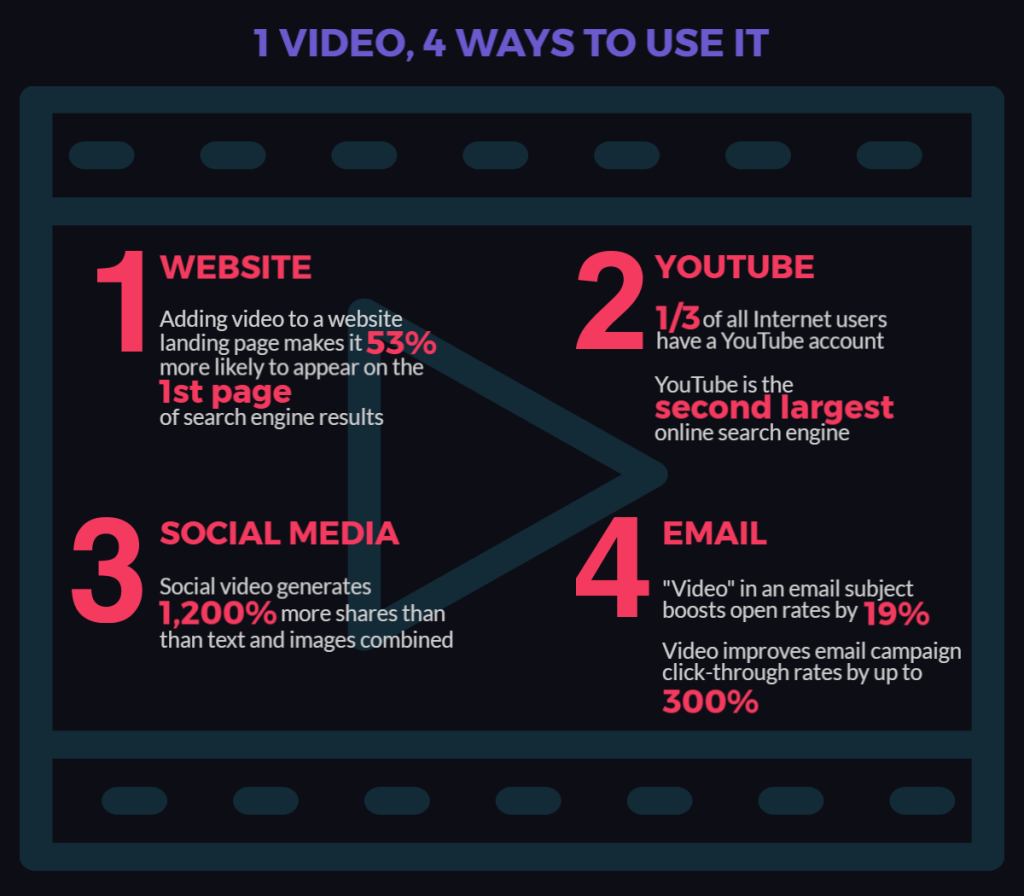
It really can’t be over exaggerated: video is THE most shared form of content on the internet. By 2018, it will account for nearly 80% of all worldwide consumer internet traffic. But it still baffles many small business owners. How do you use video? Can you really reach customers that way? And does it make a difference in sales? Incorporating video into your marketing is actually a lot easier than it sounds. And statistics show it works. Here are 4 ways to make video work for you. Post it on Your Website Websites are like digital storefronts. You spend a lot of time and effort creating curb appeal, getting customers to find you, come in and spend some time browsing. Ultimately, you want them to make a purchase. To create this digital sales cycle, you want to boost your search engine optimization, or SEO. A lot of elements go into how a website ranks in search engine results, from the average time spent on the site to the number of pages viewed. And nothing steps up to the plate to help like video. Adding a video to a landing page makes it 53% more likely to appear on the first page of Google search results. Probably because Google ranks websites with video content five times higher than websites without. That’s a big boost. Then when you have videos on your website, visitors will spend more than twice as long browsing the site, which is also good for SEO. And putting a video on a landing page not only helps SEO, it increases conversions by 80%. Create a YouTube Account Love it or hate it, YouTube is an essential part of our digital world now. It’s the second most used online search engine (after Google, of course). One third of all Internet users have a YouTube account, though you don’t need an account to watch videos, and over 50% of people watch at least one online video each day. That is a huge audience, both locally and globally. And those are customers, clients, patients and partners you could be reaching. Once you consider that YouTube is owned by Google, the connection between video and SEO becomes a little more clear. You can also use keywords, links and other SEO best practices in your YouTube video description that will drive more traffic to your website. Share it on Social Media If social media plays any role in your smal business marketing plan, your plan should also include video. Social video generates 1,200% more shares than simple text or image posts combined. People love to watch and share videos, making it a great, organic way for current customers and followers to help introduce you to new followers. There are also more traditional marketing strategies you can employ through social media, like Facebook boosted posts and ads. And as you might suspect, video ads do better than ads with only text, images and links. Send it in an Email Once you have a video embedded on your website or posted on your YouTube account, you have to tell people it’s there. Social media is a good way to spread the word, but not everyone is on social media. Everyone has an email address. Even if you don’t send out digital newsletters (by the way, you should, but that’s a different blog post), you can send the video link in an email. Just including the word “video” in your email subject line will get 19% more of your audience to open the email. Then putting a video in the email can boost your click-through rate by up to 300%. Software programs like MailChimp and Constant Contact track these open and click-through rates, so it’s simple to compare the results of a non-video email to the results of a video email. With online tracking methods, it’s pretty easy to see the results and ROI of video. You know what you spent to produce and distribute the video(s), and you can track your increase in traffic, followers and sales after adding video to your marketing mix. There’s no denying the audience is there and waiting for it, so get your business out there and be seen!
Video Marketing for Small Business
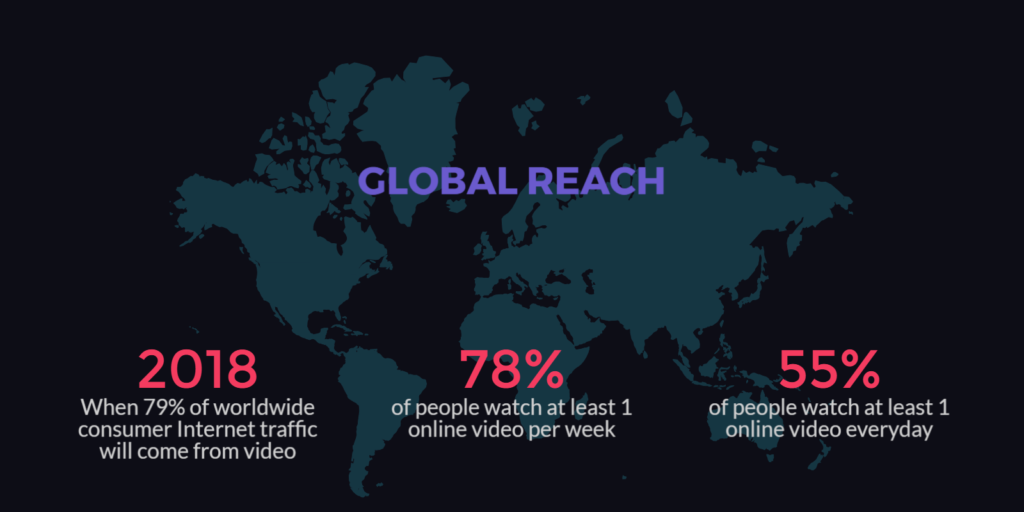
Sources: AdWeek, Cisco, Forrester, HubSpot, Insivia, Invodo and YouTube

